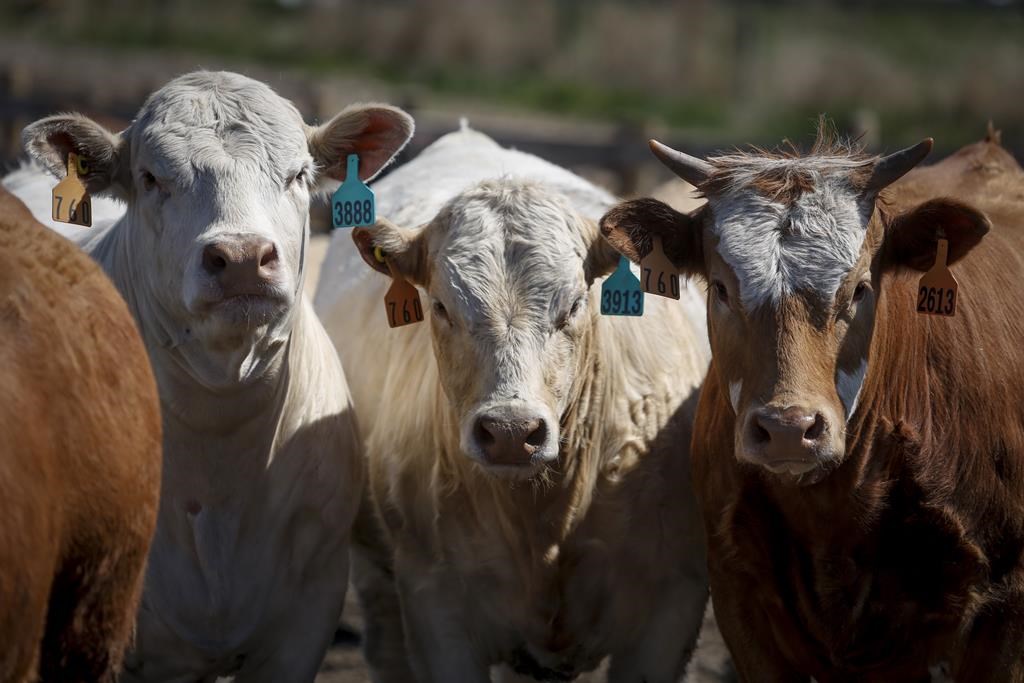Recent rain may not be enough to halt the shrinking of Canada’s cattle herd

Anxious Alberta ranchers praying for rain got their wish this week, but it may not be enough to stop the ongoing decline in Canadian cattle production.
The moisture that fell on parts of drought-parched Alberta came as a welcome reprieve to the hundreds of cattle farmers who have seen their pastures wither and their water supplies dry up this June.
But a few inches of rain won’t be enough to cut it in much of Canadian cattle country, which is still trying to dig its way out of a significant moisture deficit.
Advertisement
“I think this is the driest I’ve ever seen it,” said Bob Lowe, a rancher and feedlot operator from the Nanton area of southern Alberta.
“The grass started this spring, and came up a little bit, and then it just turned around and died. It’s supposed to be green this time of year, but it’s just grey-brown.”
According to Agriculture Canada’s Drought Monitor, 82 per cent of the agricultural regions of the three prairie provinces were either “abnormally dry” or in “moderate to extreme drought” as of the end of May.
Some ranchers have been spending hours every day this spring hauling water by truck or trailer to their cattle after their watering holes completely dried up, said Ryder Lee, general manager of the Canadian Cattle Association.
“Or they’re filling dugouts from other places with pipelines and pumps,” Lee said.
Advertisement
“There’s lots of creativity and ingenuity in the industry, but all of that takes a toll on people.”
It also takes a toll on an industry that has already been steadily shrinking for years. Last year, the size of the Canadian cattle herd fell to 12.3 million animals — the lowest level recorded since July 1, 1988.
The 2.8 per cent year-over-year reduction was in large part due to the after-effects of an extremely harsh drought on the prairies in 2021. As crops withered and feed prices skyrocketed, many ranchers sold their cattle for slaughter rather than holding onto them for breeding.
That could happen again this year, and at an even larger scale, said Rob Somerville, who has a cattle farm in east-central Alberta, near the town of Innisfail.
“There is a train of thought that people who may have hung on last time, this time, will sell,” Somerville said.
Advertisement
He added that some producers might have hesitated to sell in 2021 because cattle prices at the time were low. But as cattle numbers in North America have continued to shrink, prices have increased, hitting all-time records this spring.
“Just about everybody I’ve spoken to has already prepared a list of the cows they’re going to sell. These people won’t be leaving the industry, but they’re certainly planning a herd reduction.”
South of the border, U.S. cattle inventory is also down four per cent year-over-year due to increased heifer slaughter. According to a report by the U.S. Department of Agriculture, roughly 69 per cent of the U.S. cattle herd as of December 2022 was located in drought-stricken areas, leading to the largest contraction of the North American cattle herd in a decade.
Other catastrophes in the last two decades — including the BSE (mad cow) crisis and the 2009 financial crisis — also led ranchers to downsize their herds or exit the industry entirely.
As a result, according to Statistics Canada, there are 25 per cent fewer beef cows in Canada now than there were in 2005.
Advertisement
“After a while it’s not just an individual farm-by-farm thing, it’s an industry issue. And that has far wider implications,” Somerville said, adding that fewer cows could cause ripple effects all the way down the value chain _ potentially leading to lost jobs at feedlots, at meat-packing plants and more.
“This is a big contributor to the economy that we’re talking about.”
Winnipeg-based cattle markets analyst Jerry Klassen said he believes one or two good rains could save the industry from wide-spread liquidation of herds this year.
“You can still get one good hay crop in Alberta if you get timely rains from now moving forward,” Klassen said.
“And you’ve got these high prices. If the farmer can maintain or increase his herd, he’s going to reap the rewards over the next two or three years.”
Advertisement
But Somerville said multiple years of dry conditions have left some ranchers feeling that they’re “running out of tricks they can pull out of the hat.”
“There’s a lot of producers who have been hanging on as long as they can and they may decide now is the time to get out of the industry,” he said.
“It’s just been too many struggles, for too long.”
